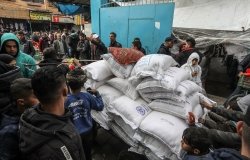Unique Aspects of Human Trafficking in Eurasia
“Human trafficking exists in all parts of the world, but it is not the same phenomenon [everywhere]. Just as slavery was different in different parts of the world historically, so is human trafficking today,” stated Louise Shelley, University Professor, School of Public Policy and Director, Terrorism, Transnational Crime and Corruption Center (TraCCC), George Mason University, and Former Title VIII-Supported Research Scholar, Kennan Institute at an 18 April 2011 Kennan Institute event. In Eurasia, Shelley continued, there exists every known form of human trafficking, including forced marriages; trafficking of organs; trafficking of children for begging; sex trafficking; and labor trafficking.
Shelley emphasized the historical roots of the human trafficking phenomenon in Eurasia, noting that the word “slave” originates from “Slav,” a population that has been enslaved multiple times over one thousand years by neighboring European and Asian peoples. During the Soviet era, the region experienced less human trafficking by crime groups; however, state-controlled prostitution was a large problem: many of the prostitutes—especially high-end prostitutes—were controlled by the KGB. A major reason why human trafficking is prevalent today in the post-Soviet region, Shelley explained, is the complicity of its residents. Indeed, in countries whose populations were previously conditioned to accept being controlled and not being able to express their rights, the likelihood of human trafficking is greater.
Shelley listed four major reasons why the Eurasian case of human trafficking in particular is unique. First, trafficking in Eurasia defies the idea that investment in targeted populations is a way to avoid exploitation. Broad consensus exists that providing girls and women with education and employment opportunities should, over time, deter traffickers from exploiting them. However, this is not the case in the former Soviet Union, where many girls and women with high school and college level educations have become victims of sex trafficking because the state does not control its organized crime. Secondly, Shelley noted that post-Soviet sex traffickers’ follow a “natural resource model.” According to this model, the traffickers are not concerned about the sustainability of the population but sell off women like oil, gas or timber. Victims of this model are repeatedly sold, increasing the likelihood abuse.
The third reason Shelley cited is that a better economy and higher levels of prosperity have not mitigated sex trafficking in this region as they have in other regions in Asia. Instead, the strength of organized crime, as well as the economic differences that exist among the countries of Eastern Europe and the post-Soviet states, have created and contributed to a greater problem. Finally, Shelley underscored the geographic reach of Eurasian sex trafficking victims, who are commonly referred to as “Natashas.” Interconnections of organized crime networks have spread these girls and women throughout the world.
Shelley then moved on to discuss labor trafficking in the former Soviet Union, where large numbers of workers from source countries such as Uzbekistan, Kyrgyzstan, and Tajikistan end up as forced laborers in recipient countries such as Russia and Ukraine. Rampant corruption among government officials, law enforcement officers and passport officials in the region, only exacerbates the problem of labor trafficking.
In what Shelley defined as “slave labor,” workers are often forced to carry drugs across borders, work and live in exploitative conditions and make little to no money. “As the traffickers have gotten savvier,” Shelley explained, “they have resorted to paying small amounts of money, because many of these people from impoverished countries are so desperate that they will not complain—and not turn on their traffickers—because they would rather have a small amount of money than no money at all.” However, the recent economic crisis has forced labor traffickers to cut even these small payments. In the recent years, remittances to Central Asian countries have notably declined. Since the 2008 economic crisis, many workers have not been paid for their period of employment, the speaker noted; additionally, the remittances that were returned to Kyrgyzstan from workers abroad halved during that time. This trend has detrimentally impacted the prosperity of Eurasian countries such as Tajikistan, where 47 percent of its total GDP comes from remittances from people overseas.
Together, sex trafficking and labor trafficking have wreaked havoc on the social demographics of many of the countries of the former Soviet Union. The removal of women of child-bearing age from Slavic countries—countries with low birthrates, high death rates, and decreasing populations—augments the demographic crisis. Furthermore, in Central Asia, the relocation of men is impacting the social patterns of source countries, and the social makeup of recipient countries, according to Shelley.
Unfortunately, Shelley asserted that the situation is not improving. Because of the phenomenon’s unique circumstances in the region, the speaker argued that Eurasia will continue to have problems for years to come. But with the right mentality and course of action, it is possible to assuage the severity of the human trafficking problem. “The political will to address it, correctly diagnose it, and work with victims to develop confidence on the issues in order to better prosecute traffickers,” is critical for improvement, Shelley concluded—and that a cutback on demand will help stem the supply.
Blair Ruble, Director, Kennan Institute
About the Author
Christian Dallago
Read More
Kennan Institute
The Kennan Institute is the premier US center for advanced research on Russia and Eurasia and the oldest and largest regional program at the Woodrow Wilson International Center for Scholars. The Kennan Institute is committed to improving American understanding of Russia, Ukraine, Central Asia, the Caucasus, and the surrounding region though research and exchange. Read more










